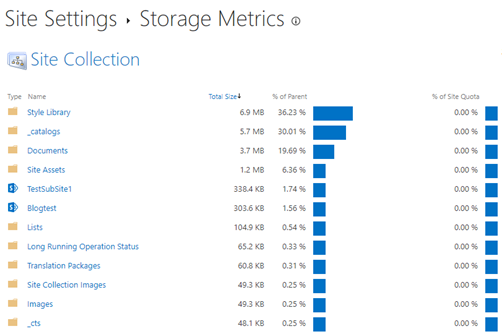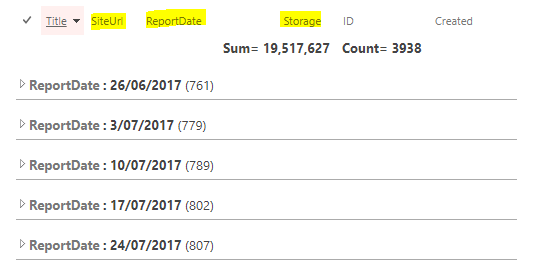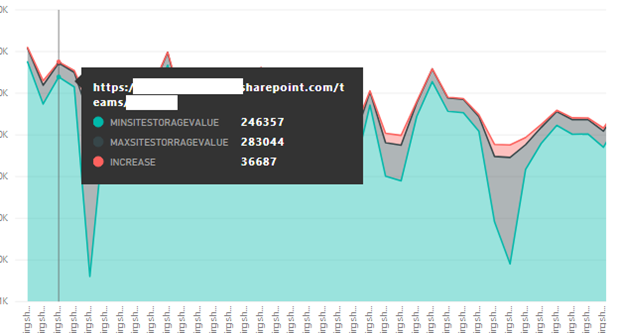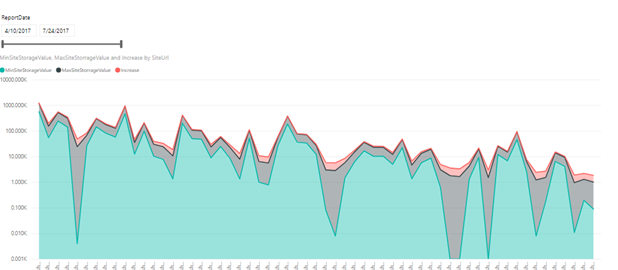Background
Office 365 users get quite a bit of storage on SharePoint Online for content, be it files, metadata, etc. But still to manage the storage and forecast as to when additional storage has to be added becomes a challenge with very limited analytics available in SharePoint Online. Since adding more storage cost money so adding before you actually require or a bit too late would not be ideal.
SharePoint Online provides two ways to track the storage one from the admin center and other one from within the site collection using Storage metrics.
In SharePoint Online tenant’s admin center it gives us a bar matrix with details about the total storage, used storage and storage available. Here customers can manage the total amount of space allocated to each site collection, the total amount of space utilized and available.
To check Storage Metrics to the Site collection under site settings we can find the Storage metrics link, storage metrics provides us with the space utilization breakdown by each sub site, library and list in that Site Collection.
As shown in the image below sub sites, libraries, lists etc. are listed with size, % of parent. This can help in finding resources which are consuming most resources.

There are some third party storage monitoring utilities available to connect to SharePoint online to determine usage patterns and trends.
But if we need to forecast storage usage, find out the site collection which is growing the most over a period of time in a tenant, with more than hundreds of site collection then it becomes a challenge to keep that track.
Solution
We can use PowerShell script and get the storage information from the tenant, store it in a SharePoint list on a periodic basis. Once we have this data available then on this data Power BI can be used to build a report which shows the growth % for each site collection over a period and get some insight to the storage.
By using PowerShell, we get heaps of information from SharePoint tenant using the command Get-SPOSite but we will here use it to get site collection list, storage information.
Get-SPOSite -Detailed -Limit All | select *
Then once the information is retrieved from SPO, use PowerShell to iterate over the data and save the relevant data to a SharePoint list.
SharePoint list Columns: Site Name/Title, Site Url, Storage, Report Run Date.
Data in SharePoint list can be filtered, grouped and sorted in list views to make it more usable for business to analyze and predict storage growth and requirements.

In order to get detailed analytics on the data, use Power BI reports which can help in putting data together in form of reports and predict the growth percentage for each site collection. PowerBI provides many connectors one of them is for SharePoint Online to easily connect with lists. To set up connector in Power BI check this Kloud Blog.
Below is the Power BI report that was built on the SharePoint list data which was pulled in using PowerShell, Data in the report below is sorted by sites with maximum storage increase within a selected interval.
Using Power BI more smarts can be added like filters, graphs and make the data more usable.
Report details
- x-axis : List of site collection
- y-axis : Storage value’s in MB
As we hover the curser over the graph it shows the Max and Min value for the storage over the selected period of time. The graph captures the sites in decreasing order of growth value by storage.



Tabular view for the report.

PowerShell script can be scheduled to run periodically and gather the data by weekly or fortnightly we can calculate the average weekly or fortnightly storage requirement for the tenant.
Secondly data captured is used to forecast weekly storage requirement. From SPO tenant we get details about total storage, used storage, storage available.
Average weekly storage requirement can be taken from list view grouped by week and aggregate of the storage as shown below in the image.

Once we have the above information then we get the average requirement for week is 24,349 MB i.e. 24 GB (difference in storage growth in two weeks) in this case, this can be used to predict the weekly storage requirement which can help forecast as to when the tenant storage is going to run out and additional storage would be required.
